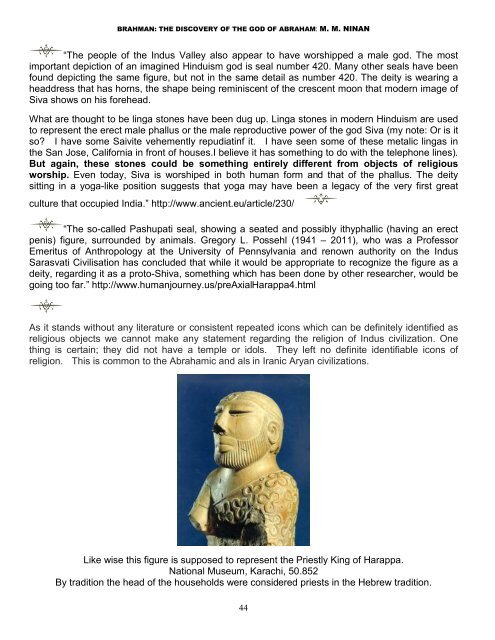You also want an ePaper? Increase the reach of your titles
YUMPU automatically turns print PDFs into web optimized ePapers that Google loves.
BRAHMAN: THE DISCOVERY OF THE GOD OF ABRAHAM: M. M. NINAN<br />
“The people of the Indus Valley also appear to have worshipped a male god. The most<br />
important depiction of an imagined Hinduism god is seal number 420. Many other seals have been<br />
found depicting the same figure, but not in the same detail as number 420. The deity is wearing a<br />
headdress that has horns, the shape being reminiscent of the crescent moon that modern image of<br />
Siva shows on his forehead.<br />
What are thought to be linga stones have been dug up. Linga stones in modern Hinduism are used<br />
to represent the erect male phallus or the male reproductive power of the god Siva (my note: Or is it<br />
so? I have some Saivite vehemently repudiatinf it. I have seen some of these metalic lingas in<br />
the San Jose, California in front of houses.I believe it has something to do with the telephone lines).<br />
But again, these stones could be something entirely different from objects of religious<br />
worship. Even today, Siva is worshiped in both human form and that of the phallus. The deity<br />
sitting in a yoga-like position suggests that yoga may have been a legacy of the very first great<br />
culture that occupied India.” http://www.ancient.eu/article/230/<br />
“The so-called Pashupati seal, showing a seated and possibly ithyphallic (having an erect<br />
penis) figure, surrounded by animals. Gregory L. Possehl (1941 – 2011), who was a Professor<br />
Emeritus of Anthropology at the University of Pennsylvania and renown authority on the Indus<br />
Sarasvati Civilisation has concluded that while it would be appropriate to recognize the figure as a<br />
deity, regarding it as a proto-Shiva, something which has been done by other researcher, would be<br />
going too far.” http://www.humanjourney.us/preAxialHarappa4.html<br />
As it stands without any literature or consistent repeated icons which can be definitely identified as<br />
religious objects we cannot make any statement regarding the religion of Indus civilization. One<br />
thing is certain; they did not have a temple or idols. They left no definite identifiable icons of<br />
religion. This is common to the Abrahamic and als in Iranic Aryan civilizations.<br />
Like wise this figure is supposed to represent the Priestly King of Harappa.<br />
National Museum, Karachi, 50.852<br />
By tradition the head of the households were considered priests in the Hebrew tradition.<br />
44


















